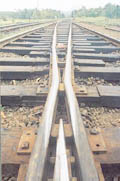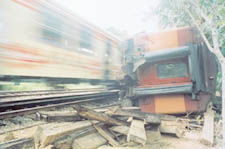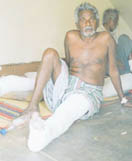
2nd September 2001
News/Comment|
Editorial/Opinion| Business|
Sports| Mirror Magazine

- Terror on the track
- Appreciations
- Filth and muck a-blowing in the wind
- Creating for himself
- Amaradeva to be feted in grand style
- Delight and wisdom
- The final trumpet heralds death and change
- Re-modelling of a model
- Kids take on big issues
- Special classes for war-weary children
- Tracing legal developments
- Paranoid Mugabe dines with a ghost
- Medical
- Letters to the editor







Terror on the track
By Hiranthi Fernando
Two train derailments and a crash at a level crossing all within one week set alarm bells ringing. On August 18, the Colombo-bound Udarata Menike was derailed at Yattalgoda, close to Alawwa. Fifteen
passengers were killed and 12 injured in the accident.
Fifteen
passengers were killed and 12 injured in the accident.
Two days later, the Yal Devi bound for Vavuniya was derailed as it entered the Polgahawela Station. Fortunately there were no casualties although the accident damaged the tracks, engine wheels, signal post and station platform. Two days before the Yattalgoda derailment, a bus crashed into a train at a level crossing at Seeduwa, killing 12 and injuring 24 people.
Conflicting reports have emerged on the possible cause of the Yal Devi derailment, while committees are still investigating the other tragedies. But for the humble commuter who has no other option but to board the morning train to get to his place of work, the spectre of these rail accidents is frighteningly real.
At Yattalgoda last week, a damaged railway wagon lay forlornly on its
side beside the rail track, a grim reminder of the tragedy of two weeks
ago. People of the area recall with a shudder the accident, which deposited
dead and wounded passengers on their doorsteps. Being used to the  sound
of the train, M. Kusumawathie, who lives in a small wattle and daub house
by the rail track paid no heed to the noise caused by the toppling carriages.
It was only when she heard her neighbours shouting that she came to her
door. Yet she could not see anything due to the cloud of dust that engulfed
her and filled the house. She ran to see if her sleeping child was safe
and could not even see him for the dust. Feeling for him on the bed, she
carried him in her arms and ran out of the house. It was then that she
saw the mayhem all around.
sound
of the train, M. Kusumawathie, who lives in a small wattle and daub house
by the rail track paid no heed to the noise caused by the toppling carriages.
It was only when she heard her neighbours shouting that she came to her
door. Yet she could not see anything due to the cloud of dust that engulfed
her and filled the house. She ran to see if her sleeping child was safe
and could not even see him for the dust. Feeling for him on the bed, she
carried him in her arms and ran out of the house. It was then that she
saw the mayhem all around.
There were people around her house screaming in shock, asking for water. Dead and injured passengers lay on the ground. Two passengers were pinned under a carriage. One woman appealed for help but although they tried hard, there was little the bystanders could do to free her trapped body from under the train. Those who had rushed to the scene, tried desperately to extricate her by digging under the carriage, but failed. All Kusumawathie could do was to give her the water that she asked for which she somehow managed to drink. Some passengers were also given clothes because their clothes had been ripped off.
Gunatilleke Banda, a Railway employee in charge of that section of the
track said they had been working at Ganegoda, when they heard of the accident
which had occurred at 2.45 p.m. It was around 5.30 p.m. when they reached
Yattalgoda, and loaded the dead on to their train. The injured had already
been taken to hospital. It was only after the crane arrived at about 8
p.m that they were able to lift the carriage off the two passengers trapped
under the wreckage. But it was too late; they  were
already dead.
were
already dead.
Gunatilleke Banda said they had laid 600 feet of new track in that section on August 16 and 17. This had been supervised by Railway officials and there had been no problem, he maintains. But now, damaged by the derailment, the track will have to be replaced once again.
At Kurunegala Hospital, V. Vairanandi and Sivakumar were still suffering from the after effects of the accident. "The train was travelling very fast," said Vairanandi, an Urban Council worker from Talawakelle. "We were frightened and I wanted to pull the emergency chain but the other people told me not to do it. Suddenly there was a noise. The carriage that I was in toppled. I was near the coupling and was flung out. When I looked up I saw the engine and four carriages had gone. Behind me, two other wagons too had toppled." Vairanandi who has multiple fractures on his leg was being discharged last Tuesday. His wife V. Periasamy Janakiamma who had also travelled on the Udarata Menike had escaped with severe bruising.
Sivakumar, 16, had started working in an eating house in Colombo a month ago. He was returning to his job after a few days of leave. Sivakumar does not remember what happened since he had been unconscious when pulled out of the train. He suffered fractures of a leg and arm and 16 stitches on his head.
Sisipia Nammuniarachchi, a school teacher, was fortunate to survive the accident unharmed. She was travelling with her two daughters and mother-in-law after a holiday in Bandarawela. "We go often to and from Bandarawela on the Udarata Menike," Ms. Nammuniarachchi said. "I felt it was travelling faster than usual. Suddenly we felt our carriage tipping over and the baggage falling. However, after a while, it seemed to settle. The train travelled a short distance and then stopped. Then we saw that three carriages had toppled. After some time another train came for us. It was only when we were leaving that we saw the dead and the wounded."
So what caused these two derailments?
The Yal Devi derailment had damaged the platform and tracks at Polgahawela Station. Railway officers of two sub departments, who inquired into this incident, have given conflicting reports. According to the Way and Works Department, which handles the laying and maintenance of tracks, the Yal Devi derailment was caused by the sudden application of brakes while the train was travelling fast, but the Motive Power Department, which supplies engines and carriages reported that the tracks were weak, with worn out rails and wastage at the points.
According to a Railway officer, a weak, worn out and cracked heel block at the point of derailment could have been the cause.
Meanwhile P.T. Wettasinghe, President of the Locomotive Operating Engineers Union (LOEU), has disputed allegations that both the Yattalgoda tragedy and Yal Devi derailment were caused by excessive speed.
He explained that engines in Sri Lanka can go only up to 55 mph. "The safety devices work in such a way that power is cut off and the engine is in idle position if the speed limit is exceeded," Mr. Wettasinghe explained.
"Then it has to be stopped and reset to get the power. So it is not fair to blame the drivers without proof."
Mr. Wettasinghe feels the tracks recently laid at Yattalgoda were faulty. "Usually when there is a fault on the tracks, two flagmen are placed on either side of the section to reduce the speed of the trains to 5 mph. That day, although there had been a flagman earlier, by the time of the accident, he had been removed and there was no warning to the driver," Mr. Wettasinghe added.
Several wagons, which are overdue for repairs are also in use due to a shortage, he said.
K.A. Premasiri, Additional General Manager, Sri Lanka Railway Department admitted that some carriages due for repairs are in use because of the shortage of wagons. "Periodically wagons need to go for scheduled repairs. There is no danger in using these wagons but it is better to get the repairs done," he said. However, he added that there were no wagons that were overdue for repairs in the recently derailed trains.
"The two derailments are not of the same nature," Mr. Premasiri said. "An independent committee headed by a retired judge has been appointed to inquire into the Yattalgoda derailment and a Departmental inquiry by senior Railway officers is also being conducted."
He declined to comment on the cause of the Yattalgoda accident as the inquiry was still in progress.
The Polgahawela derailment which was not of such a serious nature was inquired into by Railway Department officers and the two conflicting reports submitted are being examined by senior officers to determine the cause.
According to Mr. Premasiri, derailments are usually caused by track defects, vehicle defects, operational lapses or human negligence. "We have to ensure that all these sections are maintained in a safe condition," he said. "After the reports are given, the recommendations made will be implemented very soon."
What of the high rate of accidents at level crossings? "These are mainly caused by the negligence of level crossing users. However, we also have to give more protection," Mr. Premasiri added. In the case of the Seeduwa incident, one of the barriers was broken and not replaced. If it had been replaced in time, the bus driver would not have gone through. Protection at a crossing can be in one of three forms.
The cheapest is a warning board at each side. Many accidents occur at such crossings. Then there is the system of warning lights and bell. The barriers are the most expensive as staff is needed to man them.
The high cost prohibits the use of barriers at every crossing, although that is the ideal protection.
Whatever the inquiries reveal, the onus is on the Railway Department to act speedily to ensure the safety of the thousands who depend on its services each day.
![]()
Front Page| News/Comment| Editorial/Opinion| Plus| Business| Sports| Mirror Magazine
Please send your comments and suggestions on this web site to

